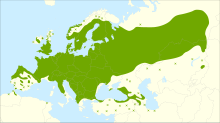Rhamnus frangula
| Frangula alnus | |
|---|---|
 |
|
| Foliage with mature and immature fruit. Penza Oblast, Russia. | |
| Scientific classification | |
| Kingdom: | Plantae |
| (unranked): | Angiosperms |
| (unranked): | Eudicots |
| (unranked): | Rosids |
| Order: | Rosales |
| Family: | Rhamnaceae |
| Genus: | Frangula |
| Species: | F. alnus |
| Binomial name | |
|
Frangula alnus Mill. |
|
 |
|
| Distribution map | |
| Synonyms | |
|
|
Frangula alnus, commonly known as the alder buckthorn, glossy buckthorn, or breaking buckthorn, is a tall deciduous shrub in the family Rhamnaceae. It is native to Europe, northernmost Africa, and western Asia, from Ireland and Great Britain north to the 68th parallel in Scandinavia, east to central Siberia and Xinjiang in western China, and south to northern Morocco, Turkey, and the Alborz and Caucasus Mountains; in the northwest of its range (Ireland, Scotland), it is rare and scattered. It is also introduced and naturalised in eastern North America.
Alder buckthorn was first formally described by Carl Linnaeus in 1753 as Rhamnus frangula. It was subsequently separated by Philip Miller in 1768 into the genus Frangula on the basis of its hermaphrodite flowers with a five-parted corolla (in Rhamnus the flowers are dioecious and four-parted); this restored the treatment of pre-Linnaean authors, notably Tournefort. Although much disputed historically, the separation of Frangula from Rhamnus is now widely accepted, being supported by recent genetic data though a few authorities still retain the genus within Rhamnus (e.g. the Flora of China).
The genus name Frangula, from Latin "to break", refers to the brittle wood. Both the common name alder buckthorn and species name alnus refer to its association with alders (Alnus) on damp sites. Unlike other "buckthorns", alder buckthorn does not have thorns. Other recorded names include glossy buckthorn and breaking buckthorn; historically, it was sometimes called "dogwood" through confusion of the leaves with those of Dogwood Cornus sanguinea.
...
Wikipedia
